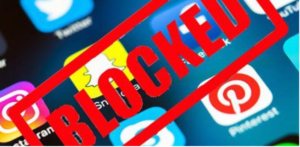By Laney Flanagan

Social media has made it possible to constantly stay in touch with friends, family, and even strangers. The onset of social media has also created yet another platform for stalkers, harassers, and abusers to contact their victims. The law has tried to keep up with this danger, especially helping those who have preexisting protective orders against abusers, but several loopholes still exist[1].
Protective orders have been shown to be helpful tools in mitigating the risk of violence toward victims[2]. In Virginia, victims of abuse are able to get three types of protective orders: (1) an emergency protective order, which lasts three days; (2) a preliminary protective order, lasting 15 days; and (3) a (final) protective order, expiring after two years[3]. In order to get a final protective order in Virginia, victims must bring the name, address, and identifying information of the person whom they are seeking protection from[4]. Further, a final protective order can only be granted after a full court hearing where both the victim and abuser are present[5]. This prevents victims of internet harassment from seeking a protective order against an anonymous internet harasser.
Several courts have held that contact via social media is a violation of an issued protective order[6]. The contact can be de minimis, with one court holding that “poking” someone on Facebook is a violation of a restraining order[7]. However, this only protects victims with preexisting protective orders, leaving victims without a protective order vulnerable to online abuse and harassment.
Online harassment comes in many different forms, and while it may not necessarily be life-threatening, it can still be emotionally harmful and cause victims severe distress[8]. In an effort to keep up with these safety concerns, Virginia has made “cyberstalking” a Class 1 misdemeanor[9]. This law makes it a crime for any person “with the intent to coerce, intimidate, or harass any person” to use a computer to “communicate obscene, vulgar, profane, lewd, lascivious, or indecent language, or to make any suggestion or proposal of an obscene nature, or threaten any illegal or immoral act”[10]. Victims of cyberstalking can report this crime to the police; however, if the identity of the harasser is unknown or hard to uncover, this crime could go unsolved[11].
Victims are more likely to block a social media profile with the hope that the harassment will end. Block features can be helpful in preventing unwanted contact, but this does not prevent stalkers from creating multiple accounts to continue harassing their victims. While Instagram attempted to stop this with its new feature allowing users to “block [an] account and any other accounts this user may create,” devoted harassers have already figured out a way around this block feature, still leaving users of the platform vulnerable to harassment[12]. Instagram plans on expanding its “nudging” features, which are designed to protect users from harassment, but abusers need more than just a “nudge” to put an end to their behavior[13].
While protective orders have been an important tool in protecting victims, they do not protect victims of internet harassment. Abusers are able to hide behind an anonymous profile in order to continue harassing their victims. Social media platforms could develop a feature allowing users to block the IP address that hosts the abuser’s profile. By going directly to the source, the victim would be able to block their abuser from contacting them through multiple accounts across multiple platforms. Law enforcement would also be able to identify abuser through the IP address, giving the cyberstalking law effect. Further, social media platforms who have received multiple reports of abuse or harassment by a profile should ban that user’s IP address from creating multiple accounts. If the platform fails to do so, it should be held vicariously liable until the user is effectively banned.[14] Of course, these are not solutions to end all forms of online harassment but, like protective orders, are useful tools in mitigating abuse toward victims.
[1] Ashely Fetters, Why It’s Hard to Protect Domestic Violence Survivors Online, The Atlantic (2018), https://www.theatlantic.com/family/archive/2018/07/restraining-orders-social-media/564614/(describing courts that have held persons liable for violating their protective orders through “poking,” “tagging,” and “following,” protected persons on various social media platforms).
[2] Christopher T. Benitez, Dale E. McNiel and Renee L. Binder, Do Protection Orders Protect?, 38 The Journal of the Am. Acad. of Psychiatry and the Law 376 at 385 (2010), https://jaapl.org/content/38/3/376.
[3] Va. Code § 16.1-253.4; Va. Code § 16.1-253.1(B); Va. Code § 16.1-279.1(B)
[4] What You Need to Know About Protective Orders, Virginia Court Sys. (2012), https://www.vacourts.gov/forms/district/info_sheet_protective_order_stalking.pdf.
[5] Va. Code § 16.1-279.1(B)
[6] See supra Fetters (describing a Tennessee court that held poking a protected person on Facebook constituted communication and thus a violation of the protective order).
[7] Id.
[8] Francesca Stevens, Jason R.C. Nurse, and Budi Arief, Cyber Stalking, Cyber Harassment, and Adult Mental Health: A Systematic Review, 24 Cyberpsychology, Behavior, and Social Networking 6 at 371 (2021), https://www.liebertpub.com/doi/full/10.1089/cyber.2020.0253 (finding that impacts of cyberstalking includes anxiety, self-harm, and suicidal thoughts).
[9] Va. Code § 18.2-152.7:1.
[10] Id.
[11] Id.
[12] Pesala Bandara, Instagram’s New Anti-Abuse Feature ‘Nudges’ Users to Be Respectful, PetaPixel (2022), https://petapixel.com/2022/10/20/instagrams-new-anti-abuse-feature-nudges-users-to-be-respectful/
[13] Id.
[14] Vicarious liability holds companies responsible for the actionable conduct of others based on the relationship between the two parties. See Vicarious Liability, Legal Information Institute, https://www.law.cornell.edu/wex/vicarious_liability#:~:text=Liability%20that%20a%20supervisory%20party,relationship%20between%20the%20two%20parties (last accessed Dec. 19, 2022).

